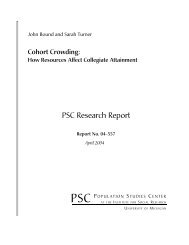Population Ageing and the Well-Being of Older Persons in Thailand ...
Population Ageing and the Well-Being of Older Persons in Thailand ...
Population Ageing and the Well-Being of Older Persons in Thailand ...
You also want an ePaper? Increase the reach of your titles
YUMPU automatically turns print PDFs into web optimized ePapers that Google loves.
Section 5: Family support <strong>and</strong> <strong>in</strong>tergenerational exchanges<br />
<strong>of</strong> liv<strong>in</strong>g arrangements with an exam<strong>in</strong>ation <strong>of</strong> trends<br />
<strong>in</strong> co-residence. As noted <strong>in</strong> <strong>the</strong> previous section, only<br />
about 5 per cent <strong>of</strong> current elders have no liv<strong>in</strong>g<br />
children. Thus childlessness is not a common<br />
limitation for co-residence. Table 5.1 shows several<br />
<strong>in</strong>dicators <strong>of</strong> co-residence based on household<br />
composition. 14 They reveal a clear decl<strong>in</strong>e <strong>in</strong><br />
co-residence with children dur<strong>in</strong>g <strong>the</strong> last two decades<br />
with <strong>the</strong> overall per cent <strong>of</strong> persons 60 <strong>and</strong> above who<br />
live <strong>in</strong> <strong>the</strong> same household with a child fall<strong>in</strong>g from<br />
77 per cent <strong>in</strong> 1986 to only 59 per cent by 2007. 15<br />
Each <strong>of</strong> <strong>the</strong> three most recent surveys <strong>in</strong>dicate higher<br />
levels <strong>of</strong> urban than rural co-residence but decl<strong>in</strong>es<br />
are evident both among urban <strong>and</strong> rural older<br />
persons. Also <strong>of</strong> <strong>in</strong>terest is <strong>the</strong> proportion who live<br />
<strong>in</strong>dependently <strong>of</strong> o<strong>the</strong>rs, ei<strong>the</strong>r liv<strong>in</strong>g alone or only<br />
with a spouse. Both <strong>the</strong> per cent <strong>of</strong> persons age 60<br />
<strong>and</strong> above who live alone <strong>and</strong>, even more so, <strong>the</strong> per cent<br />
who live only with a spouse have <strong>in</strong>creased dur<strong>in</strong>g <strong>the</strong><br />
last two decades. Toge<strong>the</strong>r, <strong>the</strong>se measures <strong>in</strong>dicate<br />
that by 2007 almost one fourth <strong>of</strong> Thais age 60 <strong>and</strong><br />
over live <strong>in</strong>dependently, up from only 11 per cent <strong>in</strong><br />
just over two decades earlier.<br />
As noted above, measures <strong>of</strong> literal co-residence<br />
ignore situations <strong>in</strong> which elderly parents <strong>and</strong> <strong>the</strong>ir<br />
children live very near each o<strong>the</strong>r but <strong>in</strong> separate<br />
dwell<strong>in</strong>gs, an arrangement that can meet many <strong>of</strong> <strong>the</strong><br />
same needs <strong>of</strong> <strong>the</strong> elderly as co-residence. Such<br />
situations are common <strong>in</strong> Thail<strong>and</strong>, especially <strong>in</strong><br />
rural sett<strong>in</strong>gs (Cowgill, 1972; Knodel &<br />
Saengtienchai, 1999). Figure 5.1 <strong>in</strong>dicates <strong>the</strong><br />
per cent <strong>of</strong> persons <strong>in</strong> 1995 <strong>and</strong> 2007 who ei<strong>the</strong>r lived<br />
with or adjacent to a child. The latter situation is more<br />
common <strong>in</strong> rural than urban areas. This difference<br />
undoubtedly reflects <strong>the</strong> greater availability <strong>of</strong> l<strong>and</strong> <strong>in</strong><br />
rural than urban areas to build separate hous<strong>in</strong>g for<br />
adult children nearby <strong>the</strong> parental home. Thus when<br />
40















